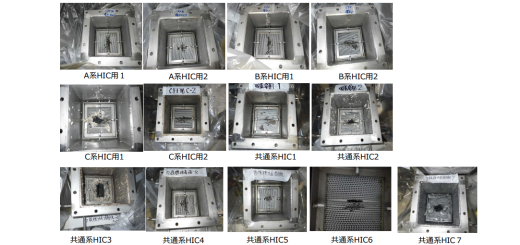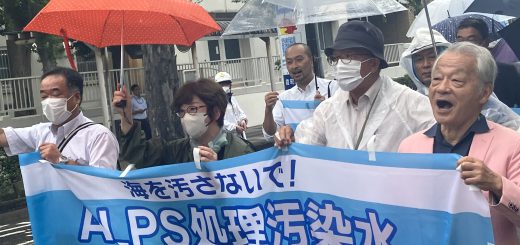Shika-2 Verdict Demands Suspension of Operations Nuke Info Tokyo No. 112
reactor cannot withstand an earthquake
On March 24th the Kanazawa District Court handed down a verdict demanding that operation of Hokuriku Electric Power Company’s Shika-2 reactor (1,358 MW ABWR) be suspended. There are currently 55 commercial reactors operating in Japan, but this is the first time that citizens have won a court case against one of these reactors on the grounds that it is unsafe to operate. As such it was a ground-breaking victory.
History of the case
Construction of Shika-2 began on 27 August 1999 and four days later, on August 31st, 135 plaintiffs from 17 prefectures lodged a case, demanding as follows:
“If this reactor were to be operated, during regular operations, or under extraordinary conditions, exposure to the radiation and radioactive material released into the environment would cause me grievous harm. It would do irreparable damage to my life and person.” For this reason, “based on my rights as an individual and my environmental right, in order to prevent this harm, I demand that operations be suspended.”
There is a history behind this case. In 1988, 100 plaintiffs lodged a case against the Shika-1 reactor (540 MW BWR). Their case was rejected by the District Court in 1994. They appealed and the High Court rejected their demands in 1998. However, although they lost their case, they extracted an acknowledgement that nuclear power plants are a negative legacy for future generations. They appealed to the Supreme Court, but their case was rejected in 2000. The Shika-2 victory therefore came 18 years after they first lodged a case against the Shika nuclear power plant.
Major features of the verdict
Reading the verdict one notices that it has several features.
First, the plaintiffs’ claims about issues such as the following were all rejected: the problems of stress corrosion cracking and pipe thinning, the intrinsic dangers of ABWRs, the hollowness of the system for preventing the emergence and escalation of problems in nuclear reactors, the defects of the system for preventing the release of radioactive materials, and the dangers associated with the use of MOX fuel. However, it should be noted that the court showed considerable sympathy for the plaintiffs’ claims. For example, it held that in the case where a pipe burst due to thinning, it could not be said that there was a possibility that this alone would result in radiation exposure in excess of the permitted limit. However, it acknowledged that it would be a different matter if a thin section of pipe burst as a result of an earthquake, and multiple other failures occurred at the same time.
Second, with reference to the Three Mile Island (1979) and Chernobyl (1986) accidents, the court rejected any presumption that such accidents could happen at the Shika-2 reactor. It held that it was not possible to claim that there is a specific possibility that an accident could occur which would cause the plaintiffs to be exposed to radiation in excess of the permitted limit.
However, the third feature of this verdict was its decisive departure from verdicts by other courts in regard to earthquakes. It took into account progress in seismology since the Southern Hyogo Earthquake of 1995. Thus, the third feature took precedence over the other two features and the plaintiffs’ case succeeded.
Earthquake design deficiencies
There are three main areas where the court found the reactor’s earthquake design to be deficient.
(1) It found the current magnitude 6.5 earthquake standard for earthquakes focused directly beneath the reactor to be inadequate. A magnitude 7.3 earthquake occurred in the west of Tottori Prefecture in October 2000 in an area where no active fault had been discovered. Based on current seismic knowledge, it should be assumed that an earthquake of magnitude 7.2 to 7.3 could occur directly beneath the reactor, even if no fault has been discovered in the area.
(2) In March 2005 the government’s Headquarters for Earthquake Research Promotion announced that a 7.6 magnitude earthquake could occur if the whole Ochigata Fault Zone were to move at once. Hokuriku Electric did not take this possibility into account. The Ochigata fault is near the Shika reactor. It had previously been thought of as several smaller faults, but the Headquarters for Earthquake Research Promotion recognized the possibility that all these faults could move together as a single fault zone.
(3) The largest predicted earthquake has until now been estimated using the Osaki Method. However, the Osaki method is not appropriate, because the results obtained using this method do not match the results obtained from empirical observation. The court referred to the Southern Hyogo Earthquake and the earthquake off the coast of Miyagi Prefecture in August 2005 as examples of earthquakes where the movement greatly exceeded the movement predicted by the Osaki Method. Therefore, it cannot be said that the safety has been assured of reactors designed to withstand earthquakes predicted using this method.
Specific danger to all plaintiffs
CNIC’s Masako Sawai gave evidence at the 27th oral hearing held on 18 March 2005. As part of her evidence she presented the results of CNIC’s calculations of the impact of an accident involving a core melt down at the Shika-2 reactor followed by a steam explosion and a breach of containment. The results, based on the WASH 1400 probabilistic risk assessment, showed that the annual radiation exposure for people within a 728 km radius would exceed the limit for a single year for radiation workers of 50 mSv (limit over 5 years of 100mSv). Since the permitted dose for members of the general public is 1 mSv/year, if the worst possible accident were to occur as a result of an earthquake, there is a danger that this dose would be greatly exceeded for even the most distant plaintiff, who lives in Kumamoto Prefecture. The court accepted CNIC’s evidence and concluded that there is a specific danger for all the plaintiffs.
Other court cases
Among the verdicts for court cases involving nuclear power plants during the 1990s, there have been a few which expressed some understanding of the plaintiffs’ claims. The Shika-1 verdict (September 1998) recognized that nuclear power plants are a negative legacy for future generations. The Tomari NPP verdict (February 1999) acknowledged that the suspension of nuclear power plants is an option. The Onagawa NPP verdict (March 1999) recognized that an even greater degree of safety is desirable. Then in January 2003 there was the verdict by the Nagoya High Court (subsequently overturned by the Supreme Court), which found that the license for the Monju fast breeder reactor was invalid. The Shika-2 verdict seems to have taken these previous verdicts into account.
Shika-2 still operating
Hokuriku Electric has appealed, so the case will now go to the High Court. As long as there are still avenues for appeal it is possible to continue operating the reactor. However, there is no doubt that the spirit of the “precautionary principle”, which this verdict upholds, will become more and more important.
Review of Earthquake Design Guidelines
The ground beneath the government’s earthquake safety design guidelines was shaken by this verdict. This is because the first and third design deficiencies identified above apply to all nuclear power plants in Japan. It seemed that the Nuclear Safety Commission’s Subcommittee on Earthquake Resisting Design was in a rush to respond when, on April 28th, it released the results of a five-year review of the guidelines (see also article in News Watch section of this issue of NIT). However, it is quite unclear whether the new draft guidelines represent an improvement on the existing guidelines. There was significant division within the Subcommittee, with some members feeling that a much stronger draft should have been produced. One got the impression that Emeritus Professor Heki Shibata (Tokyo University) was expressing his dissatisfaction when he submitted a list of critical comments and absented himself from the session at which the draft guidelines were delivered. Professor Shibata’s dissent was very telling, since he was a member of the committee which produced the existing guidelines.
The draft guidelines are very vague in several key areas. For example, whereas the existing guidelines require that designs take into account a magnitude 6.5 earthquake focused directly beneath the reactor, this figure is deleted in the new draft guidelines. It is left up to the power companies to judge the size of the earthquake to be considered. No doubt in some cases a larger earthquake will be considered, but the draft guidelines give no indication that this will always be the case.
Another vague aspect relates to the indicator for “Basic Earthquake Ground Motion”. In the existing guidelines there are two indicators, “maximum design earthquake” (S1) and “extreme design earthquake” (S2). The most important equipment for safety purposes, such as the reactor and the spent fuel pool, must be able to retain their safety functions under an “S2” Basic Earthquake Ground Motion. In the draft guidelines these indicators have been replaced by a single indicator, “Ss”. No numerical value for “Ss” is specified and it is quite unclear whether the value arrived at will be higher, the same as, or perhaps even lower than “S2” in some cases.
Under the existing guidelines faults which have been active within the last 50,000 years must be taken into account. The draft guidelines extend this period to around 130,000 years. However, they do not address the possibility acknowledged in the Shika-2 verdict that several smaller faults could move together as one. In this regard, they are already behind the times.
Perhaps it could be said that the draft guidelines are honest in acknowledging that a “residual risk” remains that a larger than predicted earthquake might strike and cause serious exposure to radiation. However, no probabilistic method of assessing this risk has been determined. Until such a method is developed, it seems that if a huge earthquake strikes, that is just too bad.
There are other questionable features of the draft guidelines: for example, the elimination of the existing requirements that nuclear power plants must be built on bedrock and that they must be rigid. It is claimed that technological advances make these requirements unnecessary. While technological progress has certainly been made, these changes reduce the margin of error.
The draft will now go out for public comment. Many people are deeply disappointed that, after such a long review process and despite the serious questions raised by the Shika-2 verdict, the Subcommittee could not produce something better. CNIC will certainly submit a strong response.
Yukio Yamaguchi (CNIC Co-Director)


